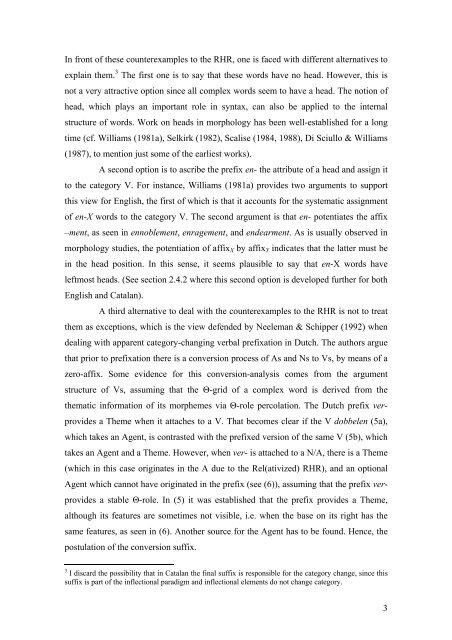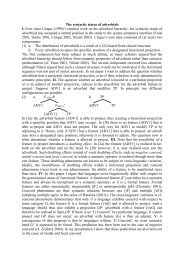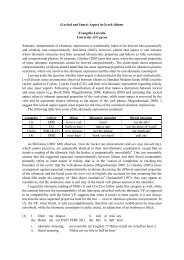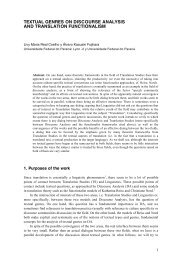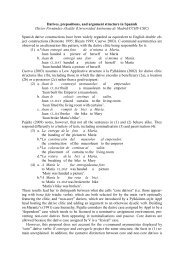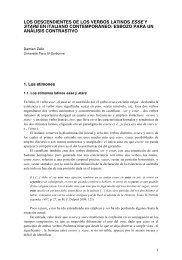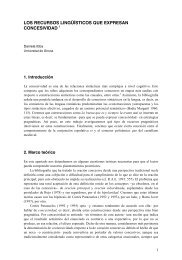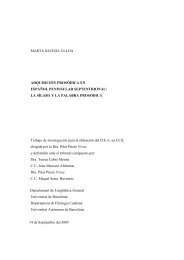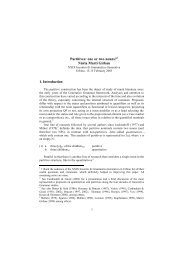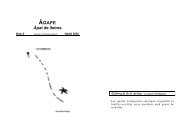Prefixation in English and Catalan - Departament de Filologia ...
Prefixation in English and Catalan - Departament de Filologia ...
Prefixation in English and Catalan - Departament de Filologia ...
You also want an ePaper? Increase the reach of your titles
YUMPU automatically turns print PDFs into web optimized ePapers that Google loves.
In front of these counterexamples to the RHR, one is faced with different alternatives to<br />
expla<strong>in</strong> them. 3 The first one is to say that these words have no head. However, this is<br />
not a very attractive option s<strong>in</strong>ce all complex words seem to have a head. The notion of<br />
head, which plays an important role <strong>in</strong> syntax, can also be applied to the <strong>in</strong>ternal<br />
structure of words. Work on heads <strong>in</strong> morphology has been well-established for a long<br />
time (cf. Williams (1981a), Selkirk (1982), Scalise (1984, 1988), Di Sciullo & Williams<br />
(1987), to mention just some of the earliest works).<br />
A second option is to ascribe the prefix en- the attribute of a head <strong>and</strong> assign it<br />
to the category V. For <strong>in</strong>stance, Williams (1981a) provi<strong>de</strong>s two arguments to support<br />
this view for <strong>English</strong>, the first of which is that it accounts for the systematic assignment<br />
of en-X words to the category V. The second argument is that en- potentiates the affix<br />
–ment, as seen <strong>in</strong> ennoblement, enragement, <strong>and</strong> en<strong>de</strong>arment. As is usually observed <strong>in</strong><br />
morphology studies, the potentiation of affixX by affixY <strong>in</strong>dicates that the latter must be<br />
<strong>in</strong> the head position. In this sense, it seems plausible to say that en-X words have<br />
leftmost heads. (See section 2.4.2 where this second option is <strong>de</strong>veloped further for both<br />
<strong>English</strong> <strong>and</strong> <strong>Catalan</strong>).<br />
A third alternative to <strong>de</strong>al with the counterexamples to the RHR is not to treat<br />
them as exceptions, which is the view <strong>de</strong>fen<strong>de</strong>d by Neeleman & Schipper (1992) when<br />
<strong>de</strong>al<strong>in</strong>g with apparent category-chang<strong>in</strong>g verbal prefixation <strong>in</strong> Dutch. The authors argue<br />
that prior to prefixation there is a conversion process of As <strong>and</strong> Ns to Vs, by means of a<br />
zero-affix. Some evi<strong>de</strong>nce for this conversion-analysis comes from the argument<br />
structure of Vs, assum<strong>in</strong>g that the Θ-grid of a complex word is <strong>de</strong>rived from the<br />
thematic <strong>in</strong>formation of its morphemes via Θ-role percolation. The Dutch prefix verprovi<strong>de</strong>s<br />
a Theme when it attaches to a V. That becomes clear if the V dobbelen (5a),<br />
which takes an Agent, is contrasted with the prefixed version of the same V (5b), which<br />
takes an Agent <strong>and</strong> a Theme. However, when ver- is attached to a N/A, there is a Theme<br />
(which <strong>in</strong> this case orig<strong>in</strong>ates <strong>in</strong> the A due to the Rel(ativized) RHR), <strong>and</strong> an optional<br />
Agent which cannot have orig<strong>in</strong>ated <strong>in</strong> the prefix (see (6)), assum<strong>in</strong>g that the prefix verprovi<strong>de</strong>s<br />
a stable Θ-role. In (5) it was established that the prefix provi<strong>de</strong>s a Theme,<br />
although its features are sometimes not visible, i.e. when the base on its right has the<br />
same features, as seen <strong>in</strong> (6). Another source for the Agent has to be found. Hence, the<br />
postulation of the conversion suffix.<br />
3 I discard the possibility that <strong>in</strong> <strong>Catalan</strong> the f<strong>in</strong>al suffix is responsible for the category change, s<strong>in</strong>ce this<br />
suffix is part of the <strong>in</strong>flectional paradigm <strong>and</strong> <strong>in</strong>flectional elements do not change category.<br />
3


